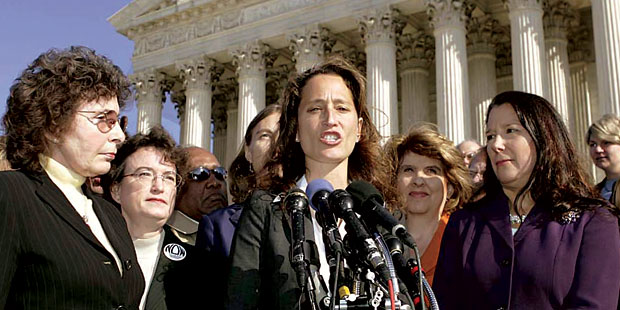Landmark Rights Protected…
Arguing before the Supreme Court, a lawyer just 10 years out of school stands up for girls’ health
Printer Friendly VersionTo call Jennifer Dalven’s first argument before the Supreme Court a challenge would be an understatement. It was November 2005 and the stakes were high— she was representing Planned Parenthood in the Court’s first abortion case in six years, just at a time when the Court was undergoing some key changes. Chief Justice William Rehnquist had died and been succeeded by John Roberts Jr.; a swing vote on many abortion cases, Justice Sandra Day O’Connor had announced her retirement over the summer; and Harriet Miers, President Bush’s choice for that seat, had just withdrawn her nomination. What’s more, Justice Samuel Alito had been nominated, but not yet confirmed, so even on the day she argued, Dalven could not be sure that Justice O’Connor would remain on the Court to decide the case. “The Court became an ever-changing landscape,” says Dalven ’95 of the months leading up to the argument. “We had to prepare for a case when we didn’t know who the members of the Court would be. We just put forth the arguments we thought were most persuasive.” Indeed, in the end, Ayotte v. Planned Parenthood of Northern New England turned out to be Justice O’Connor’s last opinion before retirement.
In January, the Supreme Court reached a unanimous decision in favor of Planned Parenthood. It found that a 2003 New Hampshire law, which prevents doctors from performing an abortion on a teenager until 48 hours after a parent has been notified, cannot be upheld because it does not allow an exception for medical emergencies. Instead of striking down the law, however, the justices sent the case back to the lower court in New Hampshire to determine whether the law should be fixed to include the medical emergency exception.
“The case raised other issues [like what legal test must courts use to decide whether to strike down an abortion law that might harm women], but they dodged those by writing a very narrow opinion, and that helped them achieve consensus,” said Dalven. As the New York Times’s legal reporter Linda Greenhouse wrote after the hearing, “Abortion law was not about to undergo a major change in the hands of the new Roberts court, at least not yet.”
Dalven, who worked as a peer educator at a family planning clinic back when she was in high school, has had a long-standing interest in reproductive rights. After law school she clerked for Judge Pierre Leval in the Second Circuit and then in 1997, after just one year at Paul, Weiss, Rifkind & Garrison, she joined the ACLU Reproductive Freedom Project.
“One of the advantages of working for a public interest institution is that they let lawyers have such fabulous experiences,” said Dalven. “I’d only been out of law school for 10 years and they had no qualms about letting me argue in front of the Supreme Court. They said, ‘It’s your case, you get to argue it.’”
As grateful as she is for the favorable ruling, Dalven said, “I am concerned that this ruling will embolden legislators to pass unconstitutional laws that are dangerous to women, and force more and more women to go to court with their doctors to protect their rights and get the care they need. Striking down the entire law would have been the right thing and I’m hoping this will still be the outcome.”
